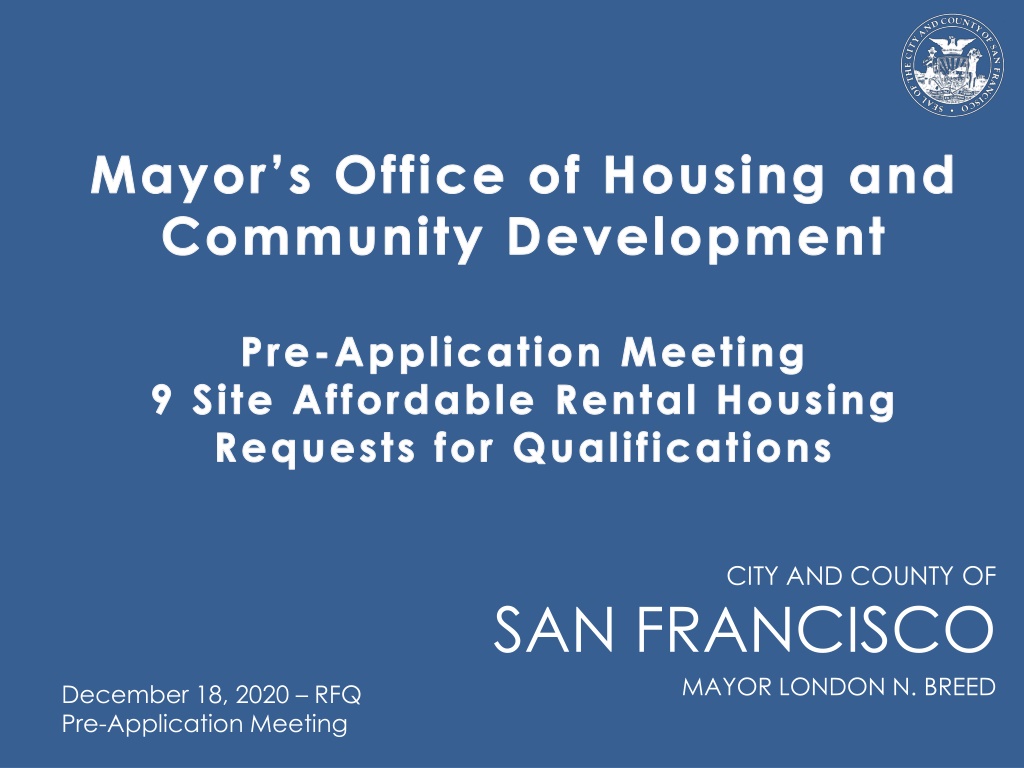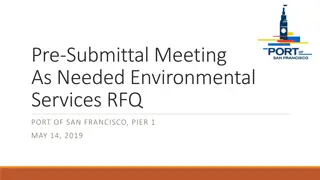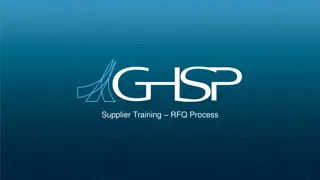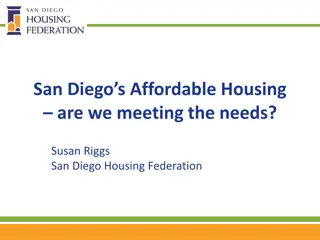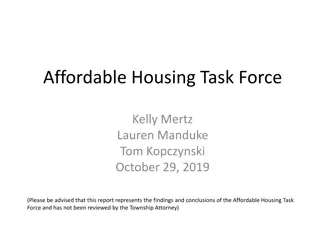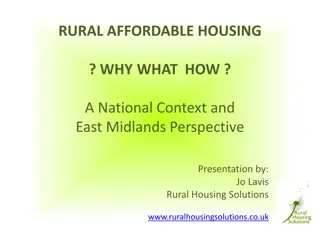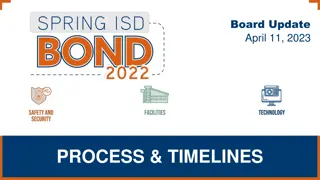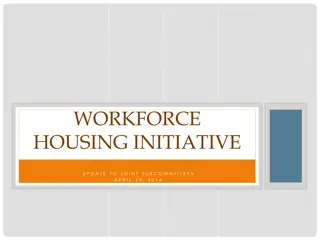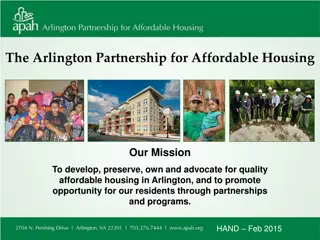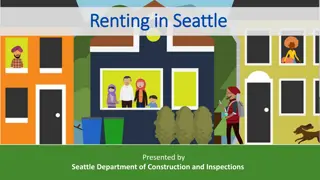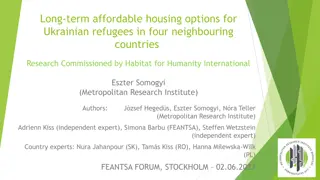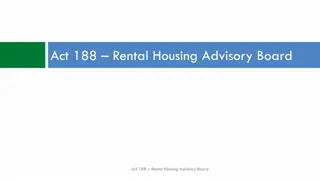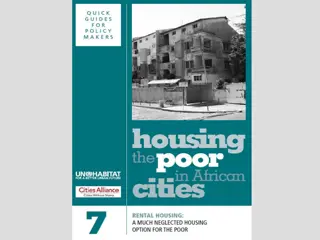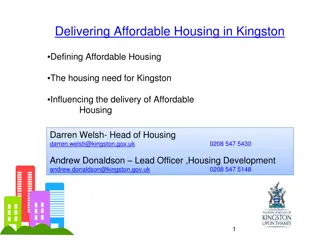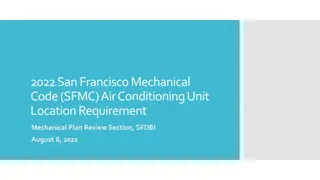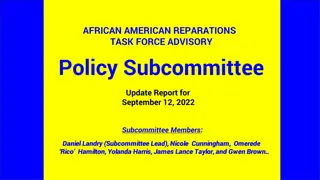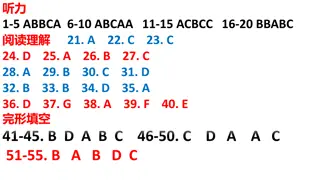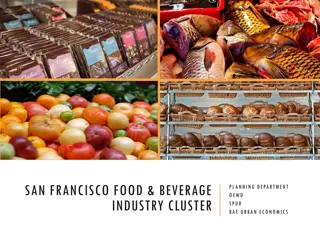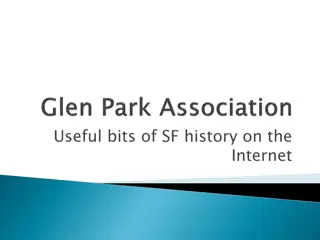Affordable Rental Housing Development RFQ in San Francisco
MOHCD in San Francisco issued an RFQ to select developers for 9 sites in their portfolio. The solicitation aims to secure developer/owner/property manager services, with future work to refine design and unit count. The selection criteria prioritize racial equity, community engagement, and diversity in project teams.
Download Presentation

Please find below an Image/Link to download the presentation.
The content on the website is provided AS IS for your information and personal use only. It may not be sold, licensed, or shared on other websites without obtaining consent from the author. Download presentation by click this link. If you encounter any issues during the download, it is possible that the publisher has removed the file from their server.
E N D
Presentation Transcript
Mayors Office of Housing and Community Development Pre-Application Meeting 9 Site Affordable Rental Housing Requests for Qualifications CITY AND COUNTY OF SAN FRANCISCO MAYOR LONDON N. BREED December 18, 2020 RFQ Pre-Application Meeting
RFQ Summary MOHCD issued a Request for Qualifications to select developers for 9 sites in our portfolio Solicitation is for the developer/owner/property manager/services provider, additional work will follow to refine design, unit count, etc. Sites were either given to MOHCD through land dedications to meet Inclusionary requirements/DA terms or purchased directly Proposed programs were determined through Project readiness Parcel size Availability of bond funds based on targeted population Alignment with Mayoral priorities MOHCD to determine opportunity for upzoning on a site by site basis Funding is available for predevelopment costs 3 sites have full development funding in GO Bond and other non-impact fee sources in pipeline Central SOMA sites development timelines are subject to availability of impact fees M A Y O R S O F F I C E O F H O U S I N G A N D C O M M U N I T Y D E V E L O P M E N T 2
Advancing Racial Equity in the RFQ Applicants must detail how they will prioritize residents who are eligible for housing preference (certificate of preference, displaced tenant housing preference, and neighborhood resident housing preference) Applicants must submit robust plans on community engagement and marketing of the units with specific focus on how they will target residents who have housing preference and lack residents Whole project teams must be diverse in staff and consultants Exploration of substantive partnerships that increase opportunity/capacity for Black and Brown developers Applicants will be scored on their ability to meaningfully meet these requirements at this first stage, rather than leaving it to the end to negotiate Diverse review committee that includes community members who do not have conflicts M A Y O R S O F F I C E O F H O U S I N G A N D C O M M U N I T Y D E V E L O P M E N T 3
Senior Housing Meet the expectations listed in the Introduction for households aged 62 and older; Serve formerly homeless seniors, in units subsidized by the City s Local Operating Subsidy Program ( LOSP ) and a City services contract. 20% of the total number of units will be LOSP-subsidized units for formerly homeless seniors; Set aside at least 5 units for households on the City s Plus Housing List, with rents set no greater than 50% AMI; Provide on-site services to formerly homeless residents at a cost- effective case management ratio (1:20); Achieve a feasible project within the funding constraints, namely, $250,000 of MOHCD subsidy per unit. Maximize the number of target population placements into the Project (COP holders, etc.) 1939 Market: LGBTQ Affirming M A Y O R S O F F I C E O F H O U S I N G A N D C O M M U N I T Y D E V E L O P M E N T 4
Family Housing Serve low-income families (in 1-3-bedroom units) unsubsidized with an income range between 30%-80% MOHCD Unadjusted San Francisco Area Median Income; Serve formerly homeless families, in units subsidized by the City s Local Operating Subsidy Program ( LOSP ) and a City services contract. The projects should provide 25% of the total number of units as LOSP-subsidized units for formerly homeless families and have a 1:20 case management ratio; Set aside at least 5 units (10 units at Pier 70) for referrals from the City s Plus Housing list with rents set at no more than 50% AMI; Evaluate the potential for childcare and provide family-friendly amenities appropriate for children. Achieve a feasible project within the funding constraints, namely, $250,000 of MOHCD subsidy per unit. Maximize the number of target population placements into the Project (COP holders, etc.) M A Y O R S O F F I C E O F H O U S I N G A N D C O M M U N I T Y D E V E L O P M E N T 5
100% Permanent Supportive Housing MOHCD and partner agency, Department of Homelessness and Supportive Housing (HSH), intend to target this housing to chronically homeless persons who are prioritized utilizing the Coordinated Entry System (CES). Up to one half of the units would include proposed financing from the State of California No Place Like Home (NPLH) program which targets adults with serious mental illness who are chronically homeless. Achieve a feasible project within the funding constraints, namely, $250,000 of MOHCD subsidy per unit. M A Y O R S O F F I C E O F H O U S I N G A N D C O M M U N I T Y D E V E L O P M E N T 6
The Sites Site # 1 2 3 4 Housing Type Estimated Notes Site Address # of Units ~70 ~90 ~100 ~120 Senior Housing Senior Housing Incl. CES and +Housing Incl. CES and +Housing Incl. CES and +Housing Incl. CES and +Housing 772 Pacific Avenue 967 Mission Street 1939 Market Street Senior Housing 1515 South Van Ness Avenue 88 Bluxome Family Housing Family Housing ~100 Incl. CES and +Housing 5 Family Housing Family Housing ~100 ~100 +Housing 6 7 Pier 70 Parcel 160 Freelon (598 Brannan) 71 Boardman Place/356 Harriet 725 Harrison Street Supportive Incl. CES and +Housing Supportive Housing ~90 Incl. CES and +Housing 8 ~120 Incl. CES and +Housing 9 Housing ~900 units of housing affordable at 30% to 80% AMI M A Y O R S O F F I C E O F H O U S I N G A N D C O M M U N I T Y D E V E L O P M E N T 7
Development Timelines Anticipated 2-3 years for predevelopment 2 years to build Occupancy in 4-5 years (~2025) Cohort 1: 772 Pacific, 1939 Market, 88 Bluxome, 160 Freelon, 1515 South Van Ness Cohort 2: 967 Mission, 71 Boardman/356 Harriet, 725 Harrison, Pier 70 C2A Timing depends on availability of inclusionary fees and competitiveness for CDLAC/TCAC funding M A Y O R S O F F I C E O F H O U S I N G A N D C O M M U N I T Y D E V E L O P M E N T 9
Development Team Members Team Members At least one San Francisco-based non-profit development entity whose mission includes the development of affordable housing in low-income communities with experience developing housing for the identified priority populations (such as Certificate of Preference Holders, displaced tenants, neighborhood residents, San Francisco residents, seniors, families, Plus Housing waitlist households and/or formerly homeless households) acting either as sole developer or as a partner in a joint venture, or joint-venture partner, defined as a nonprofit organization; A property owner entity with experience owning housing for low-income communities, including for priority populations (such as COP Holders, displaced tenants, neighborhood residents, San Francisco residents, seniors, families, Plus Housing waitlist households and/or formerly homeless households); A property management entity with experience managing housing for low-income communities, including for priority populations (such as COP Holders, displaced tenants, neighborhood residents, San Francisco residents, seniors, families, Plus Housing waitlist households and/or formerly homeless households); At least one services-providing entity with experience providing services appropriate for the intended target population(s) of each site. M A Y O R S O F F I C E O F H O U S I N G A N D C O M M U N I T Y D E V E L O P M E N T 10
Minimum Qualifications/Qualifying Qualifying Project and Team Project For Developer and Owner, a Qualifying Project must have all of the following characteristics: New construction in either a Type V over I or Type III over I construction type (not a requirement for Minimum Property Manager and Service Provision Experience) At least 75 units in size Majority multiple-bedrooms, only for family projects Mixed-use including residential (not a requirement for Minimum Service Provision Experience) Affordable to low- and very low- income households, formerly homeless residents, families and/or seniors Financed with Low-Income Housing Tax Credits. Developer: 1 project, within past 10 years Owner: 1 project, 4 years duration Manager: 1 project, 24 months Services Provider: 1 project, 36 months M A Y O R S O F F I C E O F H O U S I N G A N D C O M M U N I T Y D E V E L O P M E N T 11
RFQ Priority/Target Populations Legislated Preferences (Applicant Lottery Waitlist Order): COP Holders Displaced Tenants (20%) Neighborhood Residents (within Supervisorial District and mile radius around site) (25-40%) Live/Work in San Francisco Set-asides (not in lottery): Homeless Households via Coordinated Entry (HSH) HIV+ Households/PLWA via Plus Housing (MOHCD) M A Y O R S O F F I C E O F H O U S I N G A N D C O M M U N I T Y D E V E L O P M E N T 12
Consolidated Plan 5 Objectives 1. Families and individuals are stably housed 2. Families and individuals are resilient and economically self-sufficient 3. Communities have healthy physical, social and business infrastructure 4. Communities at risk of displacement are stabilized 5. City works to eliminate causes of racial disparities M A Y O R S O F F I C E O F H O U S I N G A N D C O M M U N I T Y D E V E L O P M E N T 13
Con Plan Target Populations 1. Households experiencing a legacy of exclusion 2. Households destabilized by system trauma 3. Households with barriers to access to opportunities 4. Extremely and very low income households 5. Households at risk of displacement M A Y O R S O F F I C E O F H O U S I N G A N D C O M M U N I T Y D E V E L O P M E N T 14
Development Expectations Part 1 Maximize the number of priority placements into the Sites (COP holders, etc.); Maximize (meet or exceed) the City s requirements for promotion of SBE/LBE organizations with contracts and local hiring with construction labor; Create opportunities for growth of smaller and Black, Brown, Indigenous and other people of color (BIPOC)-led organizations in development role; Development of affordable housing structures containing an appropriate number of units; Maximization of the number of units and density within a mid-rise construction type (75 occupied space) and/or limit of per-unit City contribution to at or below average of similar, while balancing community input on unit configuration and size - in limited cases a high rise may be acceptable to the City; Provision of ground floor commercial spaces that serve the neighborhood (including the residents of the Project), with specific programming determined through a comprehensive community outreach process where ground floor commercial uses are appropriate and feasible; Conduct community outreach to engender support for the Project; M A Y O R S O F F I C E O F H O U S I N G A N D C O M M U N I T Y D E V E L O P M E N T 15
Development Expectations Part 2 Secure construction and permanent financing that minimizes City resources to the greatest extent possible, e.g. a State of California, Housing & Community Development (HCD) loan and/or the City s No Place Like Home (NPLH) loan for homeless households; Commence construction on the Projects as soon as possible, using streamlined ministerial approval processes. For example, SB35 may be used in conjunction with the Affordable Housing Density Program or the State Density Bonus Program. Provide on-site services to formerly homeless residents at a cost-effective case management ratio (approximately 1:20) depending upon sub-population consult with the Department of Homelessness and Supportive Housing ( HSH ) for expected ratio for senior, family, TAY or other special needs populations referred from Coordinated Entry and expecting to utilize a City subsidy for operations or services. Provide initial draft marketing plans within 18 months of anticipated Temporary Certificate of Occupancy ( TCO ), outlining the affirmative steps Respondents will take to market each Project to the City s preference program participants including Certificate of Preference (COP) Holders, Displaced Tenants, and Neighborhood Residents, as well as how the marketing is consistent with the Mayor s Racial Equity statement and promotion of positive outcomes for African American San Franciscans. Note: MOHCD will be requesting demographic data regarding the Boards of Directors of member organizations of the Development Teams and of the staff of the Respondents that are selected. M A Y O R S O F F I C E O F H O U S I N G A N D C O M M U N I T Y D E V E L O P M E N T 16
RFQ Scoring Experience: up to 40 points Developer (12 pts) Owner (4 pts) Manager (8 pts) Services Providers (8 pts) Racial Equity Strategy (8 pts) Vision: up to 60 points Program Concept (20 pts) Community Engagement Strategy (10 pts) Services Delivery Strategy (10 pts) Financing & Cost Containment Approach (10 pts) Racial Equity Strategy (10 pts) M A Y O R S O F F I C E O F H O U S I N G A N D C O M M U N I T Y D E V E L O P M E N T 17
Initial Corrections/Updates Time for this meeting Site 3, 1939 Market: Restrictive Covenant does not require that all future improvements be made signatories to collective bargaining agreements only; rather it provides an alternative for paying prevailing wages. Site 6 (Pier 70 Parcel C2A) Exhibit X (check the link) Site 8, Block/lot for 71 Boardman/356 Harriet: The 71 Boardman site consists of two legal parcels, with 71 Boardman (Lot 084) parcel at 9,783 sf and 356 Harriet (Lot 112) parcel at 5,022 sf. The combined site includes 14,805 sf, or 0.34 acres. Supplemental Information to be provided: Understanding the Affordable Housing Development Process: A Primer for LGBT Aging Providers and SAGE s Housing Development Toolkit Modules 1&2 (sageusa.org) Any audit findings, outstanding performance issues, or current capacity building grants received from MOHCD must be identified and addressed in narrative response in applicable Experience section M A Y O R S O F F I C E O F H O U S I N G A N D C O M M U N I T Y D E V E L O P M E N T 18
Initial Questions Received as of 12/17/2020 part 1 1. Can the senior housing be restricted to age 55 instead of age 62? 2. Can there be a senior center developed at 967 Mission? 3. Qualifying Project characteristics, page 36: for recent RFQs (730 Stanyan and 600 7th) MOHCD has clarified that the requirement that a Qualifying Project for families has "majority multiple-bedroom units" means "a majority 1-3 bedroom units." Please confirm this is still the case. 4. Qualifying Project characteristics, page 36: please confirm that the "and/or" in the requirement that a Qualifying Project be "Affordable to low- and very low-income households, formerly homeless residents, families and/or seniors," means that a project affordable to low- and very low-income and formerly homeless families may be used as a Qualifying Project for one of the senior sites. 5. Asset Management Capacity, page 38: if the proposed owner is a partnership, should we provide an REO schedule for both partners or just the partner that will be providing Asset Management services? 6. Racial Equity Capacity, page 38: would you like us to document these items via a narrative? If so, what is the page limit for this narrative (assuming it is not combined with the Experience or Vision narratives regarding Racial Equity)? What type of demographic information would you like us to submit for Board Members and staff? Also please note that this item is not shown on the Attachment 1 - Submittal Checklist. M A Y O R S O F F I C E O F H O U S I N G A N D C O M M U N I T Y D E V E L O P M E N T 19
Initial Questions Received as of 12/17/2020 part 2 7. Evidence of Authority, page 49: may this authorizing Board Resolution be submitted after the due date for receipt of submittals if the organization's next Board Meeting falls after 1/22/21? 8. General: are all of these sites expected to move forward with predevelopment on the same timeline? If so, is predevelopment financing available for all of them? If not, are there different projected timelines for the sites that are predicated on funding availability, and what do those timelines look like? 9. Why were 725 Harrison and 71 Boardman designated supportive housing sites? 10. Does MOHCD have environmental information about 71 Boardman? The Site Information folder on the website is empty. 11. How are the terms within this phrase defined? Create opportunities for growth of smaller and Black, Indigenous and people of color, (BIPOC)-led organizations Does the organization have to be smaller AND Black, Indigenous and people of color, (BIPOC)-led? How is Smaller defined? How is Black, Indigenous and people of color, (BIPOC)-led defined? a) b) c) d) M A Y O R S O F F I C E O F H O U S I N G A N D C O M M U N I T Y D E V E L O P M E N T 20
RFQ Timeline NOVEMBER 30, 2020 RFQ available at MOHCD Website Submit completed RFQ Registration Forms to MOHCD Pre-submission conference via Teams December 18, 2020 December 18, 2020 Deadline for questions and requests for additional information DEADLINE FOR SUBMITTING QUALIFICATIONS Notification to development teams who met submission requirements Development team interviews, if necessary Announcement of selection of development teams Deadline for Objections January 4, 2021 JANUARY 22, 2021 End of February, 2021 March 2021 March/April 2021 April 2021 M A Y O R S O F F I C E O F H O U S I N G A N D C O M M U N I T Y D E V E L O P M E N T 21
Tips Separate application must be submitted for each site Stick to page limits Do not offer information that is not requested (e.g. no design drawings or proformas) Review the supplemental information provided, especially the neighborhood profiles Address any concerns previously raised by MOHCD regarding your organizational performance in your response Send any/all questions to mohcdrfq9@sfgov.org M A Y O R S O F F I C E O F H O U S I N G A N D C O M M U N I T Y D E V E L O P M E N T 22
Lets Discuss! Please click the raise hand button to ask questions. When called upon, please introduce yourself with your name and the organization you represent. M A Y O R S O F F I C E O F H O U S I N G A N D C O M M U N I T Y D E V E L O P M E N T 23
Follow-up Please check the Multisite RFQ website at https://sfmohcd.org/multisite- request-qualifications for updates and send all communications to mohcdrfq9@sfgov.org. M A Y O R S O F F I C E O F H O U S I N G A N D C O M M U N I T Y D E V E L O P M E N T 24
